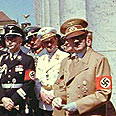
Each one has a different story, yet they all bear the same hallmarks: lied to about their past, abnormal birth certificates, an inner feeling that something isn't quite right.
Gathered Saturday in this eastern German village known for it's knights castle with fairy tale spires, some 40 "Lebensborn Kinder" gathered to share stories of aunts who turned out to be mothers, ice-cold adoptive parents who slid into alcoholism and the joy at finding a relative who embraced them as a member of their family.
And this year, four years after they first started meeting and one year after they became an officially organized group, they gathered to tell their story to the public, seeking to correct historical misconceptions that Nazi's Lebensborn program was a high-end bordellos offering blue-eyed blondes to SS officers.
May the truth be known
"We need to find the courage to publicly tell our stories as long as we are still alive," urged
Violette Wallenborn, whose mother was a Norwegian singer and father a Nazi choir director.
While the previous meetings have focused on providing support for one another and swapping tips on how to query for documents to track down still-living relatives, telling the story is increasingly an aim of the association, called Lebenssupren, or "Tracing Life."
Gisela Heidenreich, the daughter of a German secretary and an SS commander who was born into a Lebensborn home in Norway, stressed the importance of telling the story of Lebensborn in schools.
"Pupils today know all the facts, their historical knowledge is very good, but they don't have any emotional
relationship to it," she said. "The story of Lebensborn is so important because it's about families; mothers, fathers, children, it's something they can relate to."
Because 60 percent of the women who gave birth in Lebensborn homes were not married - a stigma in those conservative times - the births were kept secret. In the final days of the war, the Nazis destroyed many documents in hopes of covering their tracks.
The bordello myth
Although the bordello myth - started by a magazine shortly after the war - is not true, the Lebensborn program was the other side of the Nazi's racial experiments. While millions of Jews and others deemed "undesirable," were slaughtered, these children were carefully selected for their Aryan qualities and brought into the world in comfortable surroundings, well away from the Allied bombing raids.
Of the estimated 5,500 born into Lebensborn homes, some went home with their mothers, but many others were given over to families of high-ranking SS officers, to be raised in the Nazi doctrine.
After the Nazis overran Germany's neighbor states in 1940, German occupation soldiers were encouraged to find suitable local mates. Ten Lebensborn homes were set up, where some 8,000 children were eventually born. Two years later, the Nazis began seeking out blue-eyed, blonde-haired children in neighboring, mostly Slavic, countries and sending them back home to be "Germanized."
Searching one's roots
One of them, Folker Heinicke, 66, considers himself one of the more fortunate. Kidnapped at the age of two by the SS in what is present-day Ukraine for his Aryan qualities and shipped back to Germany by train, he was brought to the Sonnenwiese, or "Sunny Meadow" Lebensborn home near Leipzig.
There, he was adopted by a wealthy family, where he prospered. Still, a feeling nagged him. "There was always the feeling that something wasn't quite right," Heinicke said. "It happens when you have no mother, no father, no roots." Only for the past year has he seriously begun working on tracing his family - an impossibility in the days of the Cold War.
Hans-Ullrich Wesch, 64, who was born in the two-story Lebensborn home in a leafy residential area of Wernigerode, grew up in the former East Germany. There, the Stasi prevented him from finding his true parents. Only after the Berlin Wall fell could he track down his birth mother. "I am one heart and one soul with my mother," said Wesch, who found her several years ago. "She was very, very pleased when she found me. She suffered a lot as well."
His initial attempts to find his family were stopped by the East German secret police, the Stasi, who insisted that even if his parents were alive, the would have remarried and wanted nothing to do with him.
"The Stasi got involved and they said, Lebensborn was a fascist organization and no documents exist, they have all been destroyed," he said.
Like many Lebensborn children, he still suffers from the feeling that no one really wanted him. As a schoolboy, he was threatened with being returned to an orphanage if he didn't behave. "That created a fear that has stayed with me my whole life," he said.















